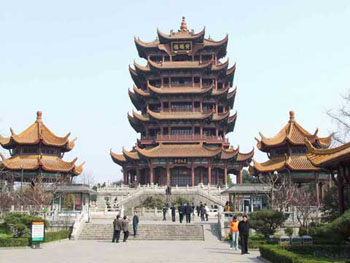search for a Trip
Introduction of Wuhan
Wuhan is situated at the confluence of the Yangtze River and its greatest branch, the Hanjiang, Wuhan (population 8 million), the provincial capital of Hubei, is one of the major economic and industrial cities in China. Located in the very center of China, and known as one of China's "Three Furnaces" (due to the incredible heat pervading in the summer months), Wuhan is a HUGE metropolis, divided into three separate districts, each the size of a small city in itself.
This is also an important domestic and foreign commercial port and the center of industry, finance, commerce, science and education for central China. With the development of the Yangtze Valley, Wuhan is becoming increasingly important both in domestic and international terms, specifically as an important education and scientific research base, due largely to the sizable university and student population here and local governmental efforts to promote this as a premier business and commercial destination.
Main attractions in Wuhan
Yellow Crane Tower
 The Yellow Crane Tower, first built in 223 AD, dominates much of Wuchang, the riverside and Wulu Lu. This is a modern Qing style reproduction of a Temple that was originally situated about 1km from this spot but was destroyed by fire in 1884. Despite the fact that this is not an important historical relic, many poets and artists over the years have reportedly found inspiration at this spot. The Tower itself is 50 meters high with five storeys stretching upwards from the ground. The Tower is covered with tiny tiles glazed in gold. Frescos decorate the walls here and the entire construction is hung together with red auspicious columns.
The Yellow Crane Tower, first built in 223 AD, dominates much of Wuchang, the riverside and Wulu Lu. This is a modern Qing style reproduction of a Temple that was originally situated about 1km from this spot but was destroyed by fire in 1884. Despite the fact that this is not an important historical relic, many poets and artists over the years have reportedly found inspiration at this spot. The Tower itself is 50 meters high with five storeys stretching upwards from the ground. The Tower is covered with tiny tiles glazed in gold. Frescos decorate the walls here and the entire construction is hung together with red auspicious columns.
Qingchuan Pavilion
Also known as the Qingchuan Building, Qingchuan Pavilion is located at the east foot of Tortoise Hill on the north side of the Yangtze River, facing the Yellow Crane Tower. A pavilion was first established here during the Ming Dynasty between 1522 and 1567.Although not an important historical spot, the pavilion has an impressive geographical location and the ingenious structure of the building has been praised by numerous literary figures over the years. The pavilion at the site today has been destroyed numerous times and the building at the site today is the result of renovations in 1983. The pavilion is made mainly with wood and stone and glass and metal have been used for the windows and door frames.
Guiyuan Temple
The Guiyuan Temple is Wuhan's most famous Buddhist temple, both in terms of religion and architecture. For several years this Temple has been considered one of the most holy Buddhist sites in central China and Buddhist followers and dignitaries including the US Secretary of State, former Singapore Prime Minister and the Cambodian King have visited the temple. Although the temple at the site today is not the original, the renovations here have been fairly faithful. The original temple building took over six years to finish; consisting of a Grand hall, Guest hall, Meditation hall and Abbot's room and covering an area of 46900 square meters. Inside, the Temple houses a collection of rare sutra, a jade Buddha and 500 gilded Arhats, all of which survived the ravages of the Cultural Revolution.
East Lake Park
It is situated in the eastern suburbs of Wuchang, the East Lake Park, is the largest open space in the city. The lake here is huge, six times the size of the West Lake in Hangzhou and divided into different thematic areas including the Listening to the Waves area, Mill Hill, and the The Poetry Composition Pavilion. The mild temperature and abundant sunshine here foster the rich plant resources in the East Lake area: 3.18 million plants of 372 different type, among which "the orchid in spring, the lotus in summer, the sweet-scented Osmanthus in autumn and the plum blossom in winter" are the most renowned. There are over 80 species of bird and fish here too of which, the Wuchang fish is the rarest and the most famous.
Climate in Wuhan
The four seasons in Wuhan are clearly marked, with extreme temperatures dominating both summer and winter here. The summer here is almost unbearable. Wuhan is one of China's "Three Furnaces" (the other two being Nanjing and Chongqing), with an intensely hot and dry heat and temperatures averaging about 32 degrees Centigrade in June, July and August.
| Month |
Jan |
Feb |
Mar |
Apr |
May |
Jun |
Jul |
Aug |
Sep |
Oct |
Nov |
Dec |
|
Temperature (Celsius) |
-1.0 |
3.1 |
12.2 |
19.0 |
22.1 |
25.0 |
36.2 |
39.2 |
31.1 |
28.0 |
20.0 |
14.2 |
China Attractions Guide
- Anhui Attractions
- Beijing Attractions
- Chongqing Attractions
- Fujian Attractions
- Gansu Attractions
- Guangdong Attractions
- Guangxi Attractions
- Guizhou Attractions
- Hainan Attractions
- Henan Attractions
- Hongkong Attractions
- Hubei Attractions
- Hunan Attractions
- Inner Mongolia Attractions
- Jiangsu Attractions
- Jiangxi Attractions
- Manchuria Attractions
- Ningxia Attractions
- Qinghai Attractions
- Shaanxi Attractions


